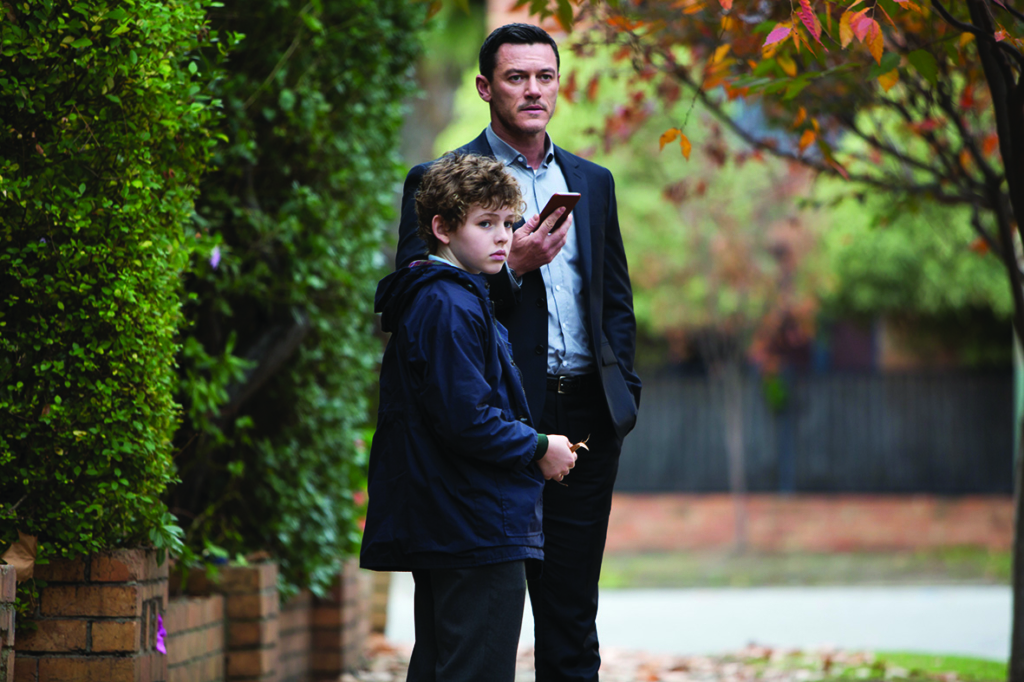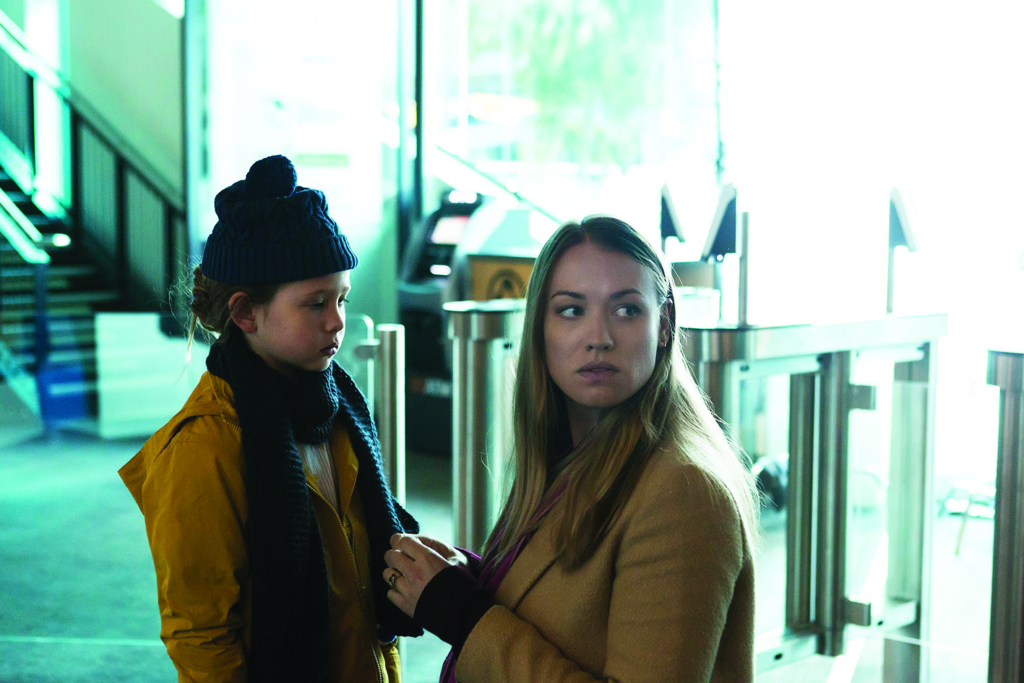The best thrillers are built on a bedrock of deception. Narrative duplicity goes hand in hand with the genre. The potency of a barbed twist – he’s been dead the whole time; she’s really his daughter; turns out he was the bad guy all along – is sharpened by its unexpected nature. The best thrillers capture their audience’s attention while drawing said attention away from whatever’s going on behind the curtain.
There’s another kind of deception found within the genre. Kim Farrant’s Angel of Mine (2019) is a great example of a thriller that – for a while, at least – deceives its audience into believing that they’re watching something other than a thriller. Certainly, that’s how it was for me. I caught the film at last year’s Melbourne International Film Festival (MIFF) with limited prior knowledge, and I spent the first act believing I was watching a mature adult drama, a character study of sorts.

That’s a reading that’s borne out, more or less, in Angel of Mine’s opening half-hour. We follow a single mother, Lizzie (Noomi Rapace). From the get-go, Farrant soaks the proceedings in a thick atmosphere of tension, but it’s less the precarious sense of danger you’d expect from a thriller than an attempt to evoke Lizzie’s anxious headspace. When Lizzie’s ex-husband, Mike (Luke Evans), reminds her that she hasn’t ‘been doing so great’, we’re already well aware; Rapace radiates hurt like a raw nerve.
It’s less clear what’s going on when she attends a child’s birthday party with her son, Thomas (Finn Little). It’s obviously a departure from Lizzie’s daily life, with the vibrancy of the party’s primary colours contrasting sharply with the dull palette used for her home. But it’s not as apparent why Lizzie fixates on a young girl playing hide-and-seek at the party – a girl who, we learn, is named Lola (Annika Whiteley), the daughter of Claire (Yvonne Strahovski) and Bernard (Richard Roxburgh). It’s a while before Luke Davies and David Regal’s screenplay tips its cards as to what precisely is going on, but Lizzie’s fascination with Lola sets in motion the escalating events that ensue.
Adjudged purely as a thriller, Angel of Mine is a modest success … when it leans into its trashier instincts, particularly in realising its outlandish twist, the film embodies the best elements of the genre it resists so cautiously in its opening act.
From this point on, Angel of Mine progressively shifts towards cultivating a thriller tone. Inch by inch, the tension builds. Gabe Noel’s string-heavy score amplifies in intensity. Lizzie’s fascination with Lola snowballs into full-blown obsession; soon, she’s stalking Claire and Bernard’s house – with a contrived story about being a prospective buyer – and taking the opportunity to corner Lola in her room to brush her hair.
Despite the storyline evolving inexorably towards a familiar thriller plotline – deranged woman’s obsession turns dangerous! – at this stage, the tone still felt closer to prestige than pulp, to me. That’s largely a matter of perspective. It’s not unheard of for similarly structured thrillers to follow their antagonists’ actions; films like The Hand That Rocks the Cradle (Curtis Hanson, 1992) and Single White Female (Barbet Schroeder, 1992) create suspense by splitting their time between the villain and their victims. The difference here is that Lizzie isn’t the antagonist. As the only character thus far with agency or perspective – we see her with her family, even watch her on a disastrous date – she’s clearly the protagonist. Thus, despite her irrational actions, she attracts audience empathy. My initial interpretation of Angel of Mine, then, was that it was taking a radical approach to a thriller premise by treating it with more care and sympathy than that traditionally found in the genre.

Based on Farrant’s comments during the Q&A following the MIFF screening, my read was off base. For starters, the intent was to elicit condemnation, not empathy: ‘Part of what we wanted [audience members] to experience was judgement […] It’s very easy to judge someone who’s emotionally wrought’[1]Kim Farrant, in Angel of Mine post-screening Q&A, Melbourne International Film Festival, 17 August 2019. (though that’s somewhat contradicted by her comments in a later interview, in which she states that ‘our hope [is] that you would definitely identify and relate to her’[2]Kim Farrant, quoted in Nancy Tapia, ‘Angel of Mine Interview: Director Kim Farrant on Crafting the Dramatic Thriller’, LRM Online, 6 September 2019, <https://lrmonline.com/news/angel-of-mine-interview-director-kim-farrant-on-crafting-the-dramatic-thriller/>, accessed 11 February 2020. ). Similarly, my understanding that the film was trying to impose a dramatic framework on a thriller screenplay was backwards; Angel of Mine is an adaptation of a French film, L’empreinte de l’ange (Safy Nebbou, 2008; retitled Angel of Mine for its UK home-entertainment release). And the original film is, in fact, far more restrained than this reinterpretation: Angel of Mine is ‘quite a departure from the French film,’ Farrant explained at MIFF. ‘Ours is a thriller.’[3]Farrant, in Angel of Mine post-screening Q&A, op. cit.
To be fair, these aspects – manipulating the audience’s sense of judgement and leaning into thriller tropes – become more apparent in Angel of Mine’s back half. By this stage, we understand that Lizzie’s obsession with Lola comes from her belief that the girl is actually Rosie, the child she lost in a hospital fire years prior. As Lizzie’s behaviour intensifies – one moment she’s lurking backstage at Lola’s dance recital; next, she’s spiriting the child away for a daytime boat ride and breaking into her parents’ house at night – we witness Farrant enacting genre conventions accordingly. The score continues to build, and the frequent shots of Lizzie looking at herself in a mirror take on a hysterical tenor. Even the structure transforms into something more conventionally thriller-adjacent, with attention moving from Lizzie to Claire; late in the piece, when Lizzie turns up uninvited to Claire’s house party, she’s introduced snapping into focus in the crowd alongside an attendant stab of discordant strings on the soundtrack.

The net effect of these structural changes is a shift in our sympathy from the apparent victim to her victimiser. The scenes we do share with Lizzie erode what remains of that sympathy. Her behaviour becomes increasingly erratic, especially when she stops taking her medication. Meanwhile, her ex-husband and parents urge her to abandon her fantasies, to overcome her crippling grief. We learn that Lizzie spent a great deal of time in in-patient mental-health care in the wake of her daughter’s death.
The heightened approach throughout this section of Angel of Mine produces the film’s strongest scenes. I was entranced by a dreamlike scene of Lizzie and Lola ice-skating together, at once captivating and nerve-racking. Scenes like this aren’t necessarily logical, but they’re gripping. One can forgive sloppy plotting – like, say, Claire electing to stay at home and pack alone rather than attend her daughter’s party at a public park (where the latter is inevitably abducted by Lizzie) – when they’re in the context of an amplified aesthetic.

And what’s a good thriller without a good twist? Angel of Mine comes to a head when it’s disclosed – in the midst of a fierce fight between Claire and Lizzie in the former’s house – that Lola is actually Lizzie’s daughter, stolen by Claire in the chaos of the aforementioned hospital fire and swapped in for her own dead child. It’s an implausible revelation (reproduced faithfully from the French film) executed with panache. Good twists in movies like this take the air out of the room; if my screening’s reaction was anything to go by, mission accomplished.
In retrospect, Farrant also cleverly laid the groundwork to support the twist while masking it with the accumulating erosion of sympathy for Lizzie. Specifically, towards the end of the film, we watch Lizzie flipping through an old scrapbook and see a photo of her at Lola’s age – looking identical. Had this evidence been provided to us earlier, we might have understood Lizzie’s seemingly baseless belief that Lola was her daughter; by concealing it until the audience had turned against Lizzie, Farrant ensured that the twist lands as intended.
Adjudged purely as a thriller, Angel of Mine is a modest success. It’s perhaps too polite for its own good in the early going, and also a touch repetitive through its midsection; there’s only so many times we need to see Lizzie staring into a mirror, or her family lamenting that she needs to get over her daughter’s death and move on. But, when it leans into its trashier instincts, particularly in realising its outlandish twist, the film embodies the best elements of the genre it resists so cautiously in its opening act.

Where Angel of Mine stumbles is in its coarser representation of psychology and trauma. This isn’t a unique problem in the genre, granted. If you’re going to centre a story on the actions of a nefariously deranged individual, it’s hard not to step over the line into exploitation. While opinions may differ, I don’t necessarily view this as an issue – provided the narrative is anchored in a sufficiently ludicrous context (as Angel of Mine is, for the most part). The issue stems from Farrant’s attempts to provide commentary on societal perceptions of mental illness and grief – a well-intended message that could’ve carefully negotiated the clash in genre expectations, but, instead, ends up presenting an archaic, simplistic view on the subject.
Frequently throughout the screenplay, supporting players characterise Lizzie as mentally unstable. Her father (Pip Miller) expresses concerns about her ability to care for her son: ‘You’re bad-tempered. You’re forgetful.’ Later, her family stages an intervention with the aid of her therapist (Mirko Grillini), who argues that she ‘would benefit from another inpatient program’. Her ex-husband tells her, ‘When you came back from that hospital, I don’t think you ever really came back.’ Even her son seems to think that she’s depressed: ‘I can hear you cry all the time […] You’re always sad.’

It’s worth emphasising that Lizzie’s family’s behaviour in these scenes, while framed as oppressive from her perspective, is largely supportive. Put up against Lizzie’s erratic – and eventually criminal – behaviour, her family’s concerns seem quite reasonable, especially when, around the midpoint of the film, we see her flush her remaining medication down the toilet. And, when compared to the (understandably) fearful reactions of Claire and Bernard – whose comments are more along the lines of ‘You’re out of your mind’ and ‘There’s no law against being crazy’ – Lizzie’s family’s responses seem to be relatively positive.
Despite this, the film presents that family as an impediment. This is partly explained by Lizzie’s position in the narrative: as she is the protagonist, any efforts to impede her agency will be portrayed as obstacles. The screenplay’s focus on mental illness, however, sits uncomfortably (for me) due to two factors. Firstly, the subsequent revelation that Lola is Lizzie’s daughter, and the happy ending that follows, suggests that Lizzie’s family’s concerns were entirely misguided. Secondly, Farrant’s discussions of her film suggest that she views Lizzie’s increasingly volatile behaviour as a manifestation of grief as much as ‘madness’. At MIFF, she even described Lizzie’s flushing of her medication as a choice to feel, positioning this behaviour as an after-effect of the character’s loss of her daughter seven years prior. Farrant has similarly foregrounded grief in a number of other interviews. She discusses it extensively in the context of performance in an interview with journalist Leslie Combemale[4]Leslie Combemale, ‘Kim Farrant on Acting, Emotional Health and Angel of Mine – Leslie Combemale Interviews’, Alliance of Women Film Journalists, 5 September 2019, <https://awfj.org/blog/2019/09/05/kim-farrant-on-acting-emotional-health-and-angel-of-mine-leslie-combemale-interviews/>, accessed 11 February 2020. , and notes its centrality to the film in another chat, this time with critic Stephen A Russell:
In a way, the film is an ode to all the dark, messy feelings when life sideswipes you, what most of society deems very uncomfortable to be around […] We have very few rituals left in Western society where we acknowledge and honour grief and let it have its course. Something in me rails against that.[5]Kim Farrant, quoted in Stephen A Russell, ‘Angel of Mine Director Kim Farrant’s Primal Scream Against Burying Grief’, SBS Movies, 23 August 2019, <https://www.sbs.com.au/movies/article/2019/08/15/angel-mine-director-kim-farrants-primal-scream-against-burying-grief>, accessed 11 February 2020.

This is an interesting approach to the film. It’s not immediately obvious from the text itself, but it does align with Farrant’s preoccupation with extreme grief in her previous feature, Strangerland (2015). But I think such emphases undermine, rather than elevate, her newer film in context. I’d agree with the suggestion that Western culture – particularly masculinised Western culture – tends to minimise grieving. Reframing Lizzie’s family’s concerns to be more about their discomfort with how she expresses her suffering rather than genuine empathy is a great idea … in theory. Unfortunately, when Lizzie’s expressions of mourning include stalking and kidnapping, that argument is immediately undermined. It’s further weakened by, as mentioned, the film’s conclusion, which ends on a hopeful tone as Lizzie and Lola (or Rosie, if you prefer) are reunited, and any suggestion of mental illness evaporates. Lizzie’s apparent ‘insanity’ was just a manifestation of a mother’s extreme loss. Not only is this psychologically dubious – admittedly, a common shortcoming within the thriller genre – in combination with a conclusion that ultimately ‘resolves’ such trauma by erasing it, but it’s also clear that Angel of Mine isn’t exactly a nuanced platform through which to reflect on how society tackles grief and/or mental illness.
Thankfully, if you set this to the side, Angel of Mine remains a sufficiently compelling thriller. While I’m not covinced its experimentations within the genre’s confines – whether they be flirtations with a more restrained dramatic mode or attempts at a robust subtext – land, when it commits to the pulpier aspects of the thriller mode, it’s entertaining and gripping enough to forgive such faults.
https://www.randrfilms.com.au/angel-of-mine
Endnotes
| 1 | Kim Farrant, in Angel of Mine post-screening Q&A, Melbourne International Film Festival, 17 August 2019. |
|---|---|
| 2 | Kim Farrant, quoted in Nancy Tapia, ‘Angel of Mine Interview: Director Kim Farrant on Crafting the Dramatic Thriller’, LRM Online, 6 September 2019, <https://lrmonline.com/news/angel-of-mine-interview-director-kim-farrant-on-crafting-the-dramatic-thriller/>, accessed 11 February 2020. |
| 3 | Farrant, in Angel of Mine post-screening Q&A, op. cit. |
| 4 | Leslie Combemale, ‘Kim Farrant on Acting, Emotional Health and Angel of Mine – Leslie Combemale Interviews’, Alliance of Women Film Journalists, 5 September 2019, <https://awfj.org/blog/2019/09/05/kim-farrant-on-acting-emotional-health-and-angel-of-mine-leslie-combemale-interviews/>, accessed 11 February 2020. |
| 5 | Kim Farrant, quoted in Stephen A Russell, ‘Angel of Mine Director Kim Farrant’s Primal Scream Against Burying Grief’, SBS Movies, 23 August 2019, <https://www.sbs.com.au/movies/article/2019/08/15/angel-mine-director-kim-farrants-primal-scream-against-burying-grief>, accessed 11 February 2020. |





